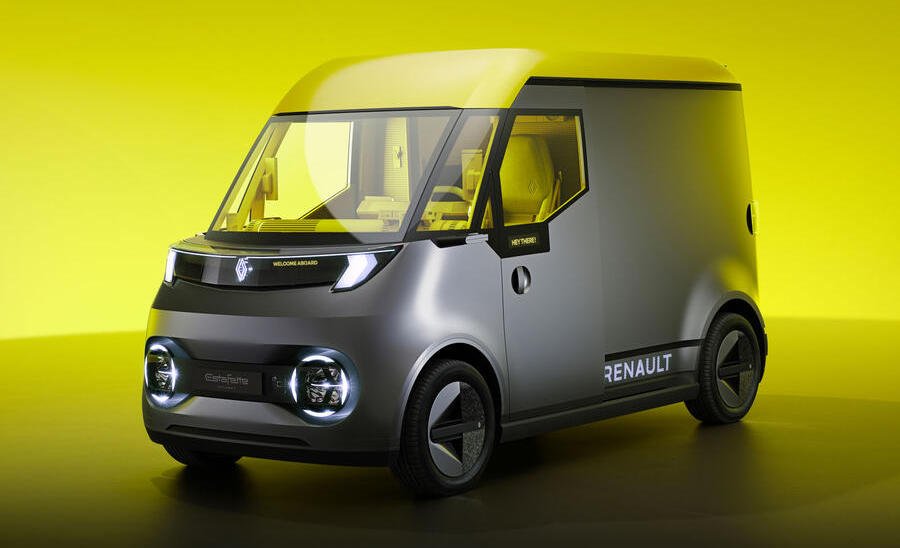Renault Estafette Revealed, Will Make You Dream of Being a Delivery Driver

The Estafette nameplate is not new in the Renault stables. It was first used in 1959, when it was slapped on a light commercial van. It stayed around as the Colorale Fourgonette successor until 1980, when it was replaced by the Trafic.
Usually, the arrival of a new van, be it the revival of a nameplate that was borderline famous on the European continent, would not have caught our attention. But just look at the thing! And wait until I tell you a thing or two about its capabilities…
Before getting into it, though, it's worth mentioning what the old Estafette meant for the industry and the carmaker. First and foremost, the van was the first Renault product to have both the engine and transmission installed at the front of the vehicle. That was a sort of requirement, as the hauler had to have enough room in the back for cargo.
Then, it came with sliding doors to allow for easier loading, and with a distinctive face, adorned by round headlights, that made it unmistakable.
All those features, and more, have been transplanted into the new concept. And they've all been dressed in a package that is "endearing, expressive and come in eye-catching pop colors."
Before talking about the endearing bits, a thing or two about the technical aspects of the van. The new Estafette has been specifically designed to be operated in crowded cities, and that means it is not particularly large.
The thing measures 4.87 x 1.92 meters (16x 6 feet), meaning its not larger than the Kangoo L2, but also that it can easily fit inside the average European parking spot. And it's quite nimble at maneuvering as well, achieving a turning radius of a little over ten meters (33 feet), similar to that of the Clio.
What the concept lacks in horizontal space is more than made up for by the van's height, which stands at 2.59 meters (8.5 feet). That makes the vehicle look particularly quirky, and also contributes to making it unmistakable.
The bodywork opens to allow access inside the cargo bay not only through the sliding doors, but also through a shutter at the rear, designed to roll onto itself. The carmaker says the sliding doors are to be used solely for unloading the van, while the shutter is used to put things in there.
One very interesting thing about the Estafette concept is its windshield. This part has been designed to seemingly wrap around the cabin, allowing a perfect view of the areas around the vehicle. The visual identity of the van is made even more impactful by the two-tone paint job, displayed here as a combination of Tropical Yellow and Helium Grey.
And speaking about the cabin, it has been made in such a way as to house only one seat, that of the driver – a foldaway seat can be installed next to it, but that is to be used solely for training purposes. Under the driver's seat no less than seven drawers have been fitted, allowing for even more loading spaces.
Ahead of the seat there is the dashboard that shows two screens, one measuring seven inches, and the other 12 inches that looks like a computer from the good old days. Two separate screens, measuring two inches, are located at the ends of the dashboard, showing images captured by the rear cameras. The dashboard too is used to store items, with open or closed storage modules built into it.
As for the cargo area at the rear, there's not much to say about it, except perhaps the fact that it comes with four foldaway shelves.
Because the van you're looking at now is nothing more than a concept, Renault did not bother to fit it with the hardware that allows it to move. We do know the van has been imagined as an electric vehicle built on an architecture called Software-Defined Vehicle (SDV), installed on a platform named FlexEVan, the work of Renault's Ampere division.
Unlike most other concepts, which die out without making it into production, the new Estafette is expected to start rolling off production lines in about two years (that's 2026). It should bring with it not only the advantages of whatever electric powertrain Renault sees fit to install, but also a 30 percent reduction in operation cost thanks to the deployment of the SDV and FlexEVan.
It remains to be seen how Renault chooses to launch the new Estafette. Not many people probably remember this, but when the original came about in 1959, it did so during a nationwide delivery tournament over in France.
Related News
